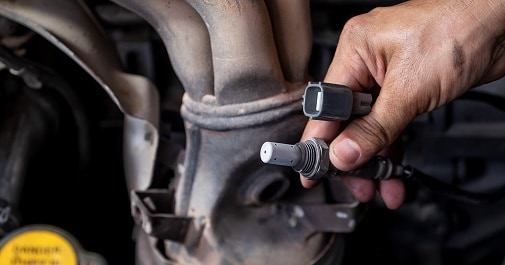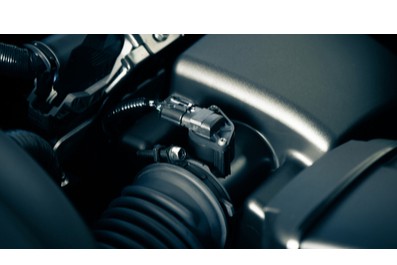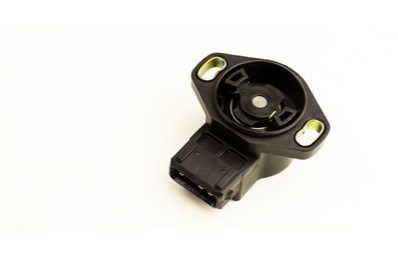There can be multiple reasons why your cargo van won’t accelerate, but it’s typically caused by problems with the following parts:
- Fuel filter
- Oxygen sensor
- Air filter
- Mass air flow sensor
- Throttle position sensor
- Timing belt/chain
- Fuel injectors
- Fuel pump
- Clutch
- Catalytic converter
- Spark plugs
- ECU
Generally speaking, your cargo van’s acceleration issues can be summed up in 3 main categories:
- Sensor defect – Typical faults are caused by problems with the mass air flow, oxygen, camshaft position, and crankshaft sensors
- Mechanical breakdown – Specific common issues are a clogged fuel filter,dirty air filter and even a clogged catalytic converter
- Actuator failure – Common defects include defective fuel pump, malfunctioning fuel injectors, and faulty spark plugs
But the good news is that these problems will trigger error codes in your vehicle’s ECU (engine control unit), which can be interpreted by a mechanic using an onboard diagnostics (OBD) reader.
The Top 10 Fixes
Even though there’s a myriad of potential causes, these are the typical reasons for not being able to accelerate.
And I will also show you some brilliant, easy and quick fixes after them.
1. Replace Fuel Filter If Clogged or Dirty
The fuel filter is an integral part of your cargo van’s fuel system as it’s responsible for preventing sludge, dirt, and debris from reaching your engine.
But over time, your fuel filter will fill up with debris and sediment, which will reduce its ability to remove contaminants from the fuel
And this will make the fuel heavy (from all the dirt and debris), which will lead to poor lubrication, and as a result, your acceleration will suffer.
Common signs of a bad fuel filter include:
- Poor acceleration
- Hard time starting
- Rough idle
- Reduced fuel economy
- Increased engine temperature
Thus, my advice is to always change your fuel filter at the correct intervals provided by the manufacturer to ensure that your van runs as smoothly as possible.
2. Replace a Defect Oxygen Sensor

The oxygen sensor is a little device in your vehicle’s exhaust system that keeps track of the exhaust emissions.
This important sensor uses the information obtained from the exhaust emissions to then determine the optimal air-to-fuel ratio for your engine at any given time.
But when there’s something wrong with the oxygen sensor, you’ll notice certain warning signs affecting your vehicle’s performance.
The typical symptoms of a faulty oxygen sensor are:
- Check Engine Light is on
- Limited or no acceleration
- Engine misfire and erratic idle
- Poor MPG
- Failed emissions test
It’s worth noting that a bad oxygen sensor can be an especially annoying issue if your van is powered by a naturally aspirated engine.
However, there’s no need to worry about it as this is not an expensive part, nor is it difficult to replace.
3. Replace a Dirty Air filter
The air system of your cargo van acts as its lungs, and the air filter is what keeps it clean.
This part has to block debris, dirt, and any type of impurities from reaching the engine’s combustion chamber, while also delivering clean air that is needed for combustion to take place.
But when your air filter is dirty or even fully clogged, your engine will literally be starved of oxygen.
The warning signs of a bad air filter are:
- Decreased engine power
- Reduced fuel efficiency
- Illuminated Check Engine Light
- The air filter looks darker in color (i.e. it’s dirty)
- Flames or black smoke coming out of the exhaust
Always check your van’s service manual to find out how often to change your air filter.
However, if you live in a big city or an area with poor air quality, my advice would be to replace your air filter at shorter intervals.
4. Clean, or Replace a Faulty Mass Air Flow Sensor

The MAF (mass air flow) sensor is an integral component of your vehicle’s air system, and it’s connected to the inlet air cleaner.
This device measures the amount of air flowing into the engine as this data is then used by the computer to determine the most optimal air-to-fuel mixture.
And as you might imagine, a defective MAF sensor will be sending false information to your engine control, which will negatively impact your driving experience.
A bad MAF will result in symptoms such as:
- Hesitation or jerking when accelerating
- Uneven idle
- Worse than usual MPG
- Difficulty starting
- Check Engine Light
- Black smoke from the exhaust
Still, keep in mind that a bad MAF sensor doesn’t necessarily mean you have to buy a new one.
Sometimes a simple cleaning procedure might do the trick.
5. Replace the Throttle Position Sensor

The TPS (throttle position sensor) is responsible for collecting data by measuring the angle and movement of your throttle.
Your engine’s brain (the ECU) needs this information to deliver the right amount of fuel and air for optimal engine performance.
And when the TPS readings are inaccurate, your engine will receive the wrong air-to-fuel mix and your vehicle will not behave abnormally.
The most common warning signs of a defect TPS include:
- Difficulty accelerating
- Loss of horsepower
- The Check Engine Light is on
- Rough idle
Now, I should mention that a TPS should generally last a very long time (i.e. the lifetime of your cargo van).
But this doesn’t make your throttle position sensor immune to electrical and physical damage, in which case you’ll probably have to replace it with a new one.
6. Worn Out or Misaligned Timing Belt/Chain
The timing belt or timing chain is connected to the crankshaft and camshaft;it plays a major role in helping to manage the engine’s pistons.
This is not a part that will last the lifetime of your van as it has to be replaced at regular intervals.
And if it’s damaged or misaligned (e.g. if it’s only off a tooth), the overall performance of your engine will suffer.
Typical symptoms of a bad timing belt include:
- A ticking sound coming from the engine
- Loss of power
- The engine won’t start
- Oil leaking in front of the engine
- Engine misfire
Even if you recently replaced your timing belt, make sure that the tension is set correctly and the belt has been installed the right way.
Otherwise, you might run into huge repair bills since a bad timing belt may damage the engine.
7. Use a Fuel Additive to Clear Fuel Injectors

The fuel injectors are a delicate and rather expensive component of the fuel delivery system of your engine.
These parts have super tiny fuel delivery passages that literally spray fuel into the combustion chamber. And over time, they can get clogged by contaminated fuel, which disrupts the adequate fuel delivery process.
As a result, your engine will not receive the correct amount of fuel and that causes an array of problems.
Here are some of the more common signs of defective fuel injectors:
- Engine vibrations and misfire
- Slow acceleration
- Poor fuel efficiency
- Your van won’t start
- Rough idle
Still, it’s not all doom and gloom when your injectors start causing issues because you might get away with the help of a simple fuel additive.
Fuel injector additives are specifically designed to clean the fuel pathways and potentially unclog them to save you from expensive repairs.
8. Replace Defective Fuel Pump
Every vehicle that’s powered by an internal combustion engine has a fuel pump that provides optimal fuel flow for the engine, and pulls fuel from the gas tank.
The fuel pump needs to be properly submerged in fuel so that it can be properly cooled.
But if there’s too little fuel in your van’s gas tank and/or if you constantly drive with a near-empty gas tank, the fuel pump will wear out much quicker.
It can also become clogged if the fuel is contaminated with debris and dirt, which can ruin your driving experience.
Typical signs of a failing fuel pump include:
- Irregular and unintended acceleration
- Difficulty starting
- Engine stalls under heavy load
- Erratic idle
- High engine temprature
If you do have to replace your fuel pump, keep in mind that prices vary depending on your cargo van and how old it is.
This means that you can potentially pay anywhere from a mere 50 bucks all the way up to several hundred dollars.
9. Worn-Out Clutch Needs Repairing

Both manual and automatic transmissions have a clutch, although automatic gearboxes rely on a more complex clutch system, and there’s no clutch pedal in these vehicles.
Thus, a worn-out clutch and low transmission fluid are serious problems that affect driveability.
In fact, a slipping clutch can make your vehicle behave in a very unpredictable manner, which can be both annoying and dangerous.
The most common warning signs of a slipping clutch are:
- RPM increase, while your speed stays roughly the same
- The vehicle is noisier in neutral gear
- Noisy acceleration
- Hard time getting into gear
Now, the clutch on a manual vehicle is meant to last anywhere between 50,000 to 100,000 miles, although this really depends on your driving style.
Automatic transmissions on the other hand, are much more complicated in their design and repairs are more expensive.
10. Bad Catalytic Converter
Catalytic converters are an integral part of each modern vehicle’s exhaust system, they help reduce harmful emissions.
This exhaust system component is made of various precious metals that are subject to theft, but that’s not the real issue here.
Although rare, catalytic converters are prone to a malfunction that can have a negative impact on engine performance.
The warning signs of a faulty catalytic converter are:
- Poor acceleration
- Check Engine Light is displayed
- Hard time starting the car
- Dark smoke from the exhaust
- The exhaust smells like rotten eggs or sulfur
Nonetheless, your typical run-of-the-mill catalytic converter should last 10+ years without any issues whatsoever.
But any potential problems with this part and your cargo van’s performance will be greatly affected as well as the emissions it produces.
3 Simple Methods for Fixing Your Acceleration Issues
Before you go to your local auto repair shop, I know they are obvious but make sure to also give these neat easy fixes a try. Its a bit like when an IT person tells you to turn your computer off and on again, they’re obvious but sometimes they are all you need to do.
1. Ensure that the Emergency Brake is Disengaged
First and foremost, grab the lever of the handbrake and make sure that it’s not pulled up i.e. in the ‘engaged’ position.
Also, check your dashboard for any warnings. If your van’s electronics work as intended, there should be a warning sign displayed on your dashboard if the emergency brake is engaged.
Note that a fully or partially engaged emergency brake will cause your rear brakes to drag, which will have a noticeable effect on your cargo van’s acceleration.
2. Fill up Your Gas Tank
Head over to the nearest gas station and fill up your cargo van with enough fuel.
It’s possible that your fuel was at a near-empty level, even if the fuel gauge says otherwise (the readings might be off).
And as a result of driving with little to no fuel, your engine will not be able to accelerate properly.
On top of that, make sure to use the right type of fuel for your engine at the right octane number.
This is very important because driving with bad fuel (e.g. the wrong type and/or contaminated with debris and dirt) can potentially clog up the fuel filter and fuel lines.
3. Make Sure that There’s Nothing Under the Gas Pedal
Perhaps there’s an object stuck somewhere underneath or behind the gas pedal that limits its movement when pressed.
And if such an object gets stuck behind or underneath your vehicle’s gas pedal, you can be certain that your ability to accelerate will be greatly affected.
What to do If Nothing Helps?
Go to a qualified mechanic with a diagnostics tool who can read your van’s computer for any stored fault codes.
Modern vehicles are equipped with an engine control unit (ECU) a.k.a. engine control module (ECM) electronic systems that act as the brain of your cargo van.
Thus, when some part or component malfunctions, a corresponding error will be saved in the ECU, which is meant to help the mechanic pinpoint the exact cause for the problem.
Just keep in mind that mechanics typically charge for an ECU diagnostic scan, but if none of the quick fixes help, then this will be your best bet of finding out what’s wrong and fixing it.
Conclusion
There are quite a lot of potential reasons why your cargo van won’t accelerate.
But all of the possible causes can be narrowed down to 3 main categories:
- Defects with some of the sensors
- Mechanical failure of certain parts
- Actuator malfunctions (issues with the electronic control systems)
Nonetheless, the good news is that your problem will more often than not be something trivial such as a clogged fuel filter or a dirty MAF sensor.
Now, don’t forget to check our other articles for even more helpful cargo van info!

